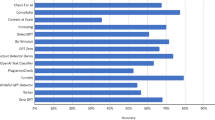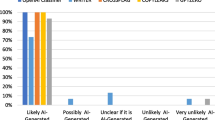Abstract
Cross-language plagiarism detection deals with the automatic identification and extraction of plagiarism in a multilingual setting. In this setting, a suspicious document is given, and the task is to retrieve all sections from the document that originate from a large, multilingual document collection. Our contributions in this field are as follows: (1) a comprehensive retrieval process for cross-language plagiarism detection is introduced, highlighting the differences to monolingual plagiarism detection, (2) state-of-the-art solutions for two important subtasks are reviewed, (3) retrieval models for the assessment of cross-language similarity are surveyed, and, (4) the three models CL-CNG, CL-ESA and CL-ASA are compared. Our evaluation is of realistic scale: it relies on 120,000 test documents which are selected from the corpora JRC-Acquis and Wikipedia, so that for each test document highly similar documents are available in all of the six languages English, German, Spanish, French, Dutch, and Polish. The models are employed in a series of ranking tasks, and more than 100 million similarities are computed with each model. The results of our evaluation indicate that CL-CNG, despite its simple approach, is the best choice to rank and compare texts across languages if they are syntactically related. CL-ESA almost matches the performance of CL-CNG, but on arbitrary pairs of languages. CL-ASA works best on “exact” translations but does not generalize well.






Similar content being viewed by others
Notes
If only pairs of languages are considered, many more aligned documents can be extracted from Wikipedia, e.g., currently more than 200,000 between English and German.
References
Ballesteros, L. A. (2001). Resolving ambiguity for cross-language information retrieval: A dictionary approach. PhD thesis, University of Massachusetts Amherst, USA, Bruce Croft.
Barrón-Cedeño, A., Rosso, P., Pinto, D., & Juan A. (2008). On cross-lingual plagiarism analysis using a statistical model. In S. Benno, S. Efstathios, & K. Moshe (Eds.), ECAI 2008 workshop on uncovering plagiarism, authorship, and social software misuse (PAN 08) (pp. 9–13). Patras, Greece.
Baum, L. E. (1972). An inequality and associated maximization technique in statistical estimation of probabilistic functions of a Markov process. Inequalities, 3, 1–8.
Berger, A., & Lafferty, J. (1999). Information retrieval as statistical translation. In SIGIR’99: Proceedings of the 22nd annual international ACM SIGIR conference on research and development in information retrieval (vol. 4629, pp. 222–229). Berkeley, California, United States: ACM.
Brin, S., Davis, J., & Garcia-Molina, H. (1995). Copy detection mechanisms for digital documents. In SIGMOD ’95 (pp. 398–409). New York, NY, USA: ACM Press.
Brown, P. F., Della Pietra, S. A., Della Pietra, V. J., & Mercer R. L. (1993). The mathematics of statistical machine translation: Parameter estimation. Computational Linguistics, 19(2), 263–311.
Ceska, Z., Toman, M., & Jezek, K. (2008). Multilingual plagiarism detection. In AIMSA’08: Proceedings of the 13th international conference on artificial intelligence (pp. 83–92). Berlin, Heidelberg: Springer.
Clough, P. (2003). Old and new challenges in automatic plagiarism detection. National UK Plagiarism Advisory Service, http://www.ir.shef.ac.uk/cloughie/papers/pas_plagiarism.pdf.
Dempster A. P., Laird N. M., Rubin D. B. (1977). Maximum likelihood from incomplete data via the EM algorithm. Journal of the Royal Statistical Society. Series B (Methodological), 39(1), 1–38.
Dumais, S. T., Letsche, T. A., Littman, M. L., & Landauer, T. K. (1997). Automatic cross-language retrieval using latent semantic indexing. In D. Hull & D. Oard (Eds.), AAAI-97 spring symposium series: Cross-language text and speech retrieval (pp. 18–24). Stanford University, American Association for Artificial Intelligence.
Gabrilovich, E., & Markovitch, S. (2007). Computing semantic relatedness using Wikipedia-based explicit semantic analysis. In Proceedings of the 20th international joint conference for artificial intelligence, Hyderabad, India.
Hoad T. C., & Zobel, J. (2003). Methods for identifying versioned and plagiarised documents. American Society for Information Science and Technology, 54(3), 203–215.
Levow, G.-A., Oard, D. W., & Resnik, P. (2005). Dictionary-based techniques for cross-language information retrieval. Information Processing & Management, 41(3), 523–547.
Littman, M., Dumais, S. T., & Landauer, T. K. (1998). Automatic cross-language information retrieval using latent semantic indexing. In Cross-language information retrieval, chap. 5 (pp. 51–62). Kluwer.
Maurer, H., Kappe, F., & Zaka, B. (2006). Plagiarism—a survey. Journal of Universal Computer Science, 12(8), 1050–1084.
McCabe, D. (2005). Research report of the Center for Academic Integrity. http://www.academicintegrity.org.
Mcnamee, P., & Mayfield, J. (2004). Character N-gram tokenization for European language text retrieval. Information Retrieval, 7(1–2), 73–97.
Meyer zu Eissen, S., & Stein, B. (2006). Intrinsic plagiarism detection. In M. Lalmas, A. MacFarlane, S. M. Rüger, A. Tombros, T. Tsikrika, & A. Yavlinsky (Eds.), Proceedings of the European conference on information retrieval (ECIR 2006), volume 3936 of Lecture Notes in Computer Science (pp. 565–569). Springer.
Meyer zu Eissen, S., Stein, B., & Kulig, M. (2007). Plagiarism detection without reference collections. In R. Decker & H. J. Lenz (Eds.), Advances in data analysis (pp. 359–366), Springer.
Och, F. J., & Ney, H. (2003). A systematic comparison of various statistical alignment models. Computational Linguistics, 29(1), 19–51.
Pinto, D., Juan, A., & Rosso, P. (2007). Using query-relevant documents pairs for cross-lingual information retrieval. In V. Matousek & P. Mautner (Eds.), Lecture Notes in Artificial Intelligence (pp. 630–637). Pilsen, Czech Republic.
Pinto, D., Civera, J., Barrón-Cedeño, A., Juan, A., & Rosso, P. (2009). A statistical approach to cross-lingual natural language tasks. Journal of Algorithms, 64(1), 51–60.
Potthast, M. (2007). Wikipedia in the pocket-indexing technology for near-duplicate detection and high similarity search. In C. Clarke, N. Fuhr, N. Kando, W. Kraaij, & A. de Vries (Eds.), 30th Annual international ACM SIGIR conference (pp. 909–909). ACM.
Potthast, M., Stein, B., & Anderka, M. (2008). A Wikipedia-based multilingual retrieval model. In C. Macdonald, I. Ounis, V. Plachouras, I. Ruthven, & R. W. White (Eds.), 30th European conference on IR research, ECIR 2008, Glasgow , volume 4956 LNCS of Lecture Notes in Computer Science (pp. 522–530). Berlin: Springer.
Pouliquen, B., Steinberger, R., & Ignat, C. (2003a). Automatic annotation of multilingual text collections with a conceptual thesaurus. In Proceedings of the workshop ’ontologies and information extraction’ at the Summer School ’The Semantic Web and Language Technology—its potential and practicalities’ (EUROLAN’2003) (pp. 9–28), Bucharest, Romania.
Pouliquen, B., Steinberger, R., & Ignat, C. (2003b). Automatic identification of document translations in large multilingual document collections. In Proceedings of the international conference recent advances in natural language processing (RANLP’2003) (pp. 401–408). Borovets, Bulgaria.
Stein, B. (2007). Principles of hash-based text retrieval. In C. Clarke, N. Fuhr, N. Kando, W. Kraaij, & A. de Vries (Eds.), 30th Annual international ACM SIGIR conference (pp. 527–534). ACM.
Stein, B. (2005). Fuzzy-fingerprints for text-based information retrieval. In K. Tochtermann & H. Maurer (Eds.), Proceedings of the 5th international conference on knowledge management (I-KNOW 05), Graz, Journal of Universal Computer Science. (pp. 572–579). Know-Center.
Stein, B., & Anderka, M. (2009). Collection-relative representations: A unifying view to retrieval models. In A. M. Tjoa & R. R. Wagner (Eds.), 20th International conference on database and expert systems applications (DEXA 09) (pp. 383–387). IEEE.
Stein, B., & Meyer zu Eissen, S. (2007). Intrinsic plagiarism analysis with meta learning. In B. Stein, M. Koppel, & E. Stamatatos (Eds.), SIGIR workshop on plagiarism analysis, authorship identification, and near-duplicate detection (PAN 07) (pp. 45–50). CEUR-WS.org.
Stein, B., & Potthast, M. (2007). Construction of compact retrieval models. In S. Dominich & F. Kiss (Eds.), Studies in theory of information retrieval (pp. 85–93). Foundation for Information Society.
Stein, B., Meyer zu Eissen, S., & Potthast, M. (2007). Strategies for retrieving plagiarized documents. In C. Clarke, N. Fuhr, N. Kando, W. Kraaij, & A. de Vries (Eds.), 30th Annual international ACM SIGIR conference (pp. 825–826). ACM.
Steinberger, R., Pouliquen, B., Widiger, A., Ignat, C., Erjavec, T., Tufis, D., & Varga, D. (2006). The JRC-Acquis: A multilingual aligned parallel corpus with 20+ languages. In Proceedings of the 5th international conference on language resources and evaluation (LREC’2006).
Steinberger, R., Pouliquen, B., & Ignat, C. (2004). Exploiting multilingual nomenclatures and language-independent text features as an interlingua for cross-lingual text analysis applications. In Proceedings of the 4th Slovenian language technology conference. Information Society 2004 (IS’2004).
Vinokourov, A., Shawe-Taylor, J., & Cristianini, N. (2003). Inferring a semantic representation of text via cross-language correlation analysis. In S. Becker, S. Thrun, & K. Obermayer (Eds.), NIPS-02: Advances in neural information processing systems (pp. 1473–1480). MIT Press.
Yang, Y., Carbonell, J. G., Brown, R. D., & Frederking, R. E. (1998). Translingual information retrieval: Learning from bilingual corpora. Artificial Intelligence, 103(1–2), 323–345.
Author information
Authors and Affiliations
Corresponding author
Additional information
This work was partially supported by the TEXT-ENTERPRISE 2.0 TIN2009-13391-C04-03 project and the CONACyT-Mexico 192021 grant.
Rights and permissions
About this article
Cite this article
Potthast, M., Barrón-Cedeño, A., Stein, B. et al. Cross-language plagiarism detection. Lang Resources & Evaluation 45, 45–62 (2011). https://doi.org/10.1007/s10579-009-9114-z
Published:
Issue Date:
DOI: https://doi.org/10.1007/s10579-009-9114-z




